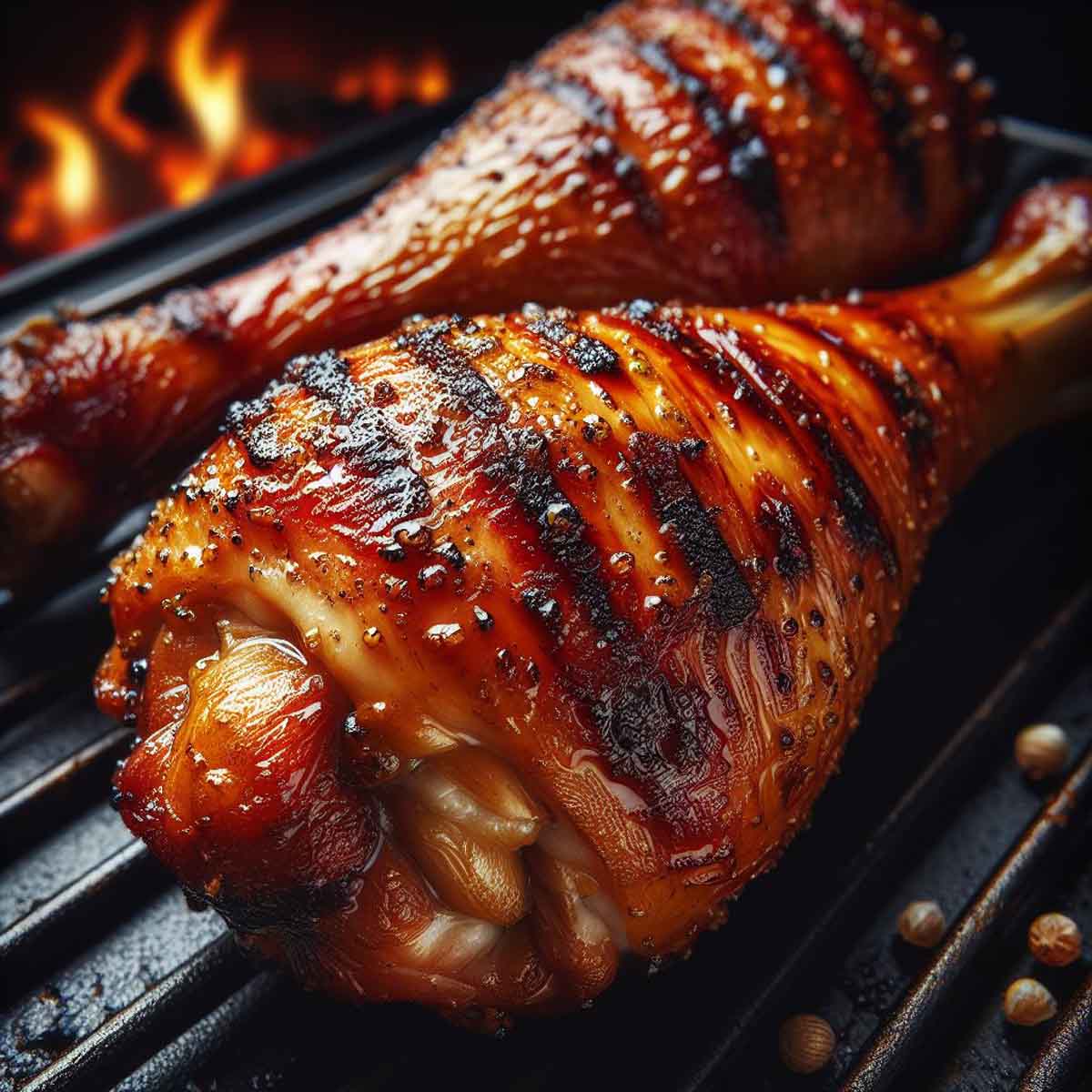Juicy, smoky, and flavorful smoked turkey legs are too delicious to enjoy just once. If you have some leftovers or pre-smoked turkey legs waiting to be savored again, this guide will help you master the art of reheating them on a grill.
Grilling not only warms them up but can also enhance their smoky flavor, making them taste as if they’ve just come out of the smoker! So, how to reheat smoked turkey legs on a grill?
Table of Contents
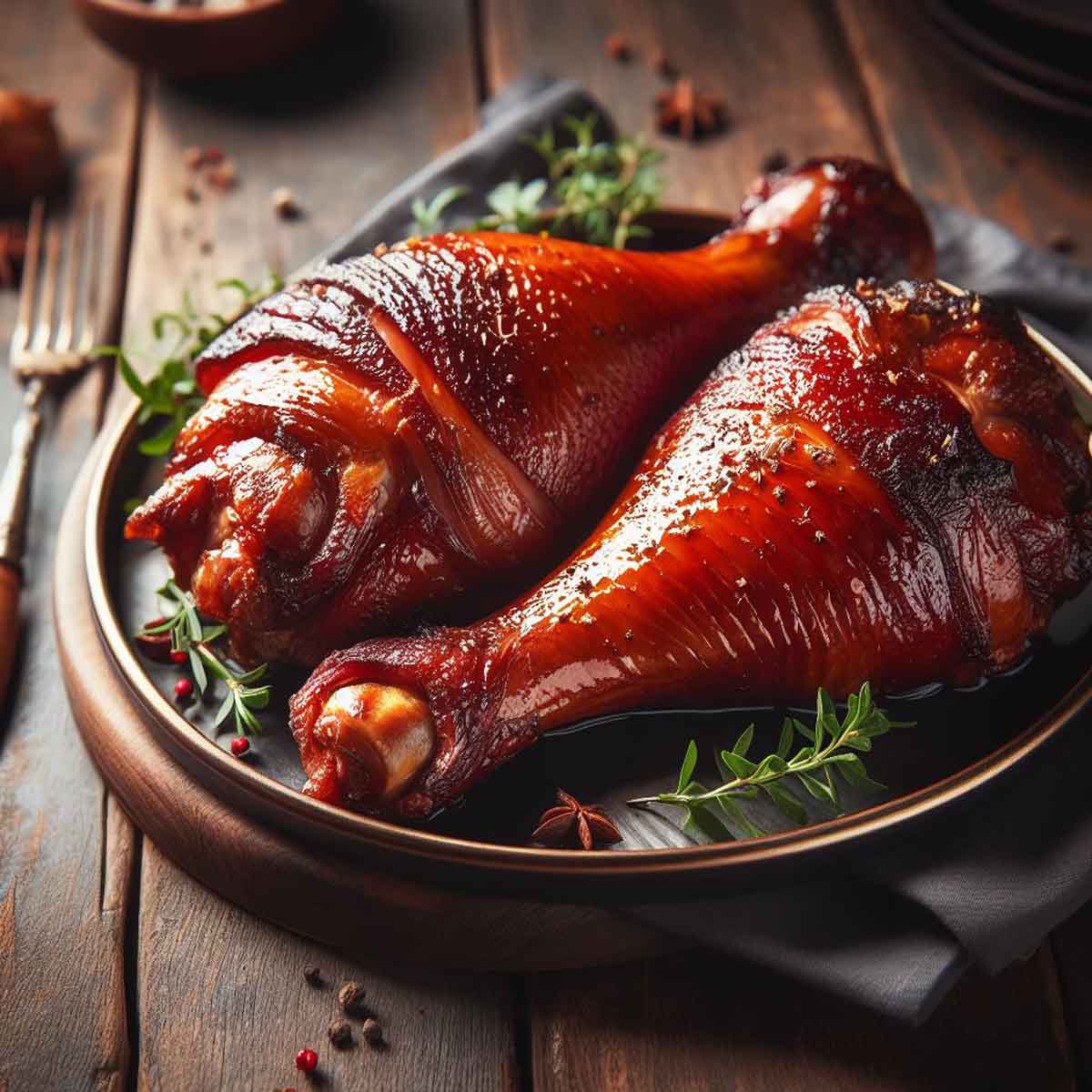
Key Preparation Steps Before Reheating Smoked Turkey Legs
Thawing Your Turkey Legs
Before you fire up the grill, it’s essential to thaw your turkey legs properly. According to the USDA Food Safety and Inspection Service (FSIS), turkey legs should be thawed in the refrigerator, in a bowl of cold water, or in the microwave if you’re short on time.
- Refrigerator: It can take up to 24 hours for turkey legs to thaw in the fridge. Place them on the bottom shelf to prevent any juices from contaminating other foods.
- Cold Water: Submerge the turkey legs in their original packaging or a leak-proof bag in cold water, changing the water every 30 minutes. This can take up to a few hours depending on the size of the legs.
- Microwave: If you choose the microwave, use the defrost setting and cook immediately after thawing because some areas of the turkey leg may become warm and begin to cook during microwave defrosting.
Testing the Internal Temperature for Safety
Once thawed, you’ll want to ensure the turkey legs are reheated to the right temperature. The FSIS guidelines emphasise controlling the temperature during cooking and reheating to prevent bacterial growth. Aim to reheat the turkey to an internal temperature of 165 degrees Fahrenheit. A meat thermometer can be your best friend here, allowing you to check the temperature without guessing.
- Insert the thermometer into the thickest part of the turkey leg, avoiding bone, to get an accurate reading.
Preparing Your Grill and Turkey Legs for Reheating
So how to reheat smoked turkey legs on a grill? Before you start grilling, make sure your grill is clean and at the right temperature. You’ll be aiming for a medium heat, which allows for a gentle reheating process without burning the skin.
- Preheat the grill to about 300 degrees Fahrenheit.
- Pat the turkey legs dry and apply a light coat of olive oil or other oil of your preference to help the skin crisp up.
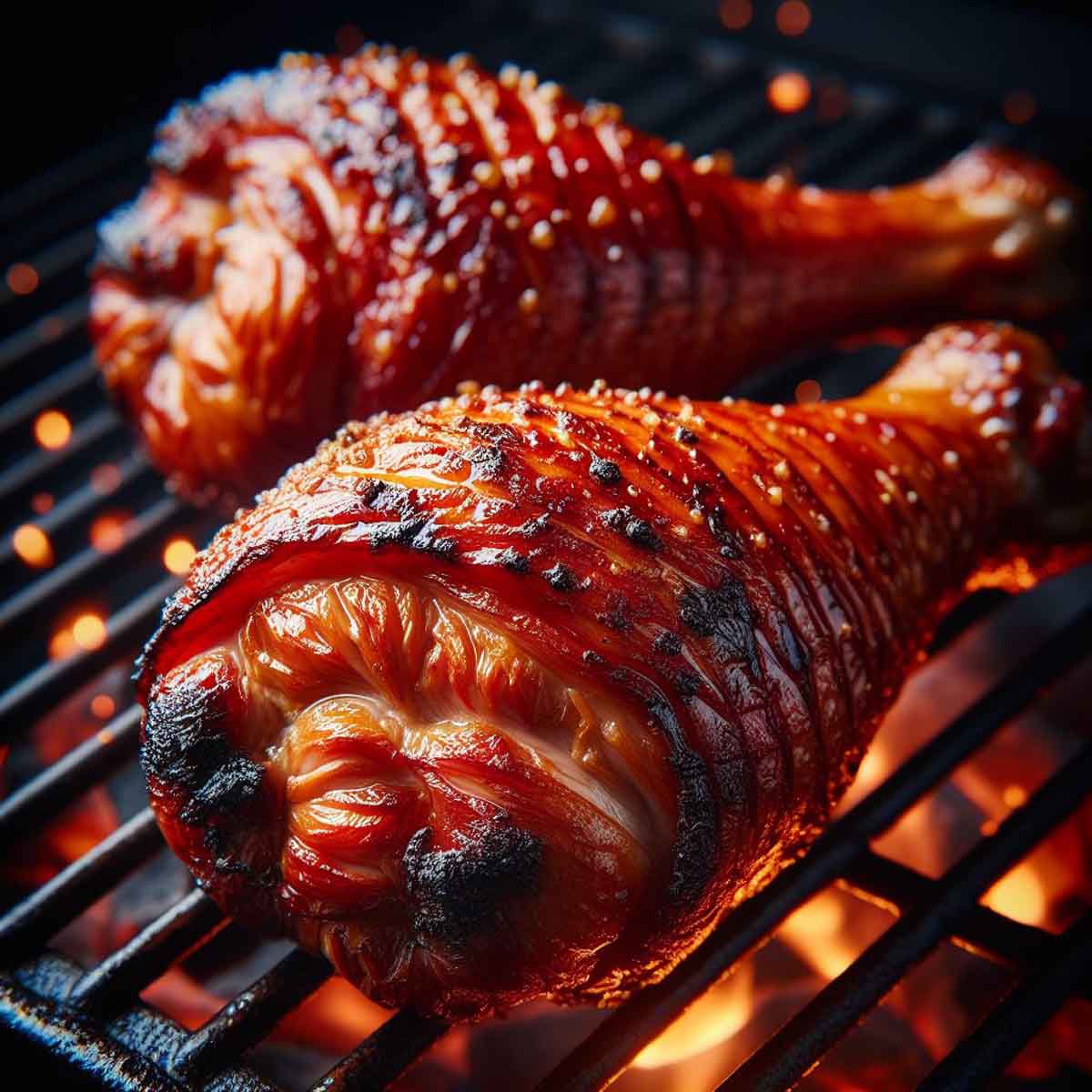
Next, we’ll dive into the best ways to reheat those scrumptious turkey legs on the grill, ensuring every bite is as good as the first.
The Best Ways How to Reheat Smoked Turkey Legs on a Grill
Direct Grilling for Crispy Skin
If you’re after that irresistible crispy skin, reheating your turkey legs directly over the flames is the way to go. However, this method requires some attention to prevent burning:
- Preheat the grill to a medium heat, around 300-350 degrees Fahrenheit.
- Place the turkey legs directly on the grill grates.
- Turn the legs occasionally, every 5 minutes, to ensure even heating.
- Continue grilling until the internal temperature reaches 165 degrees Fahrenheit.
Using high heat can give you a crispy result, but monitor the turkey legs closely to avoid charring.
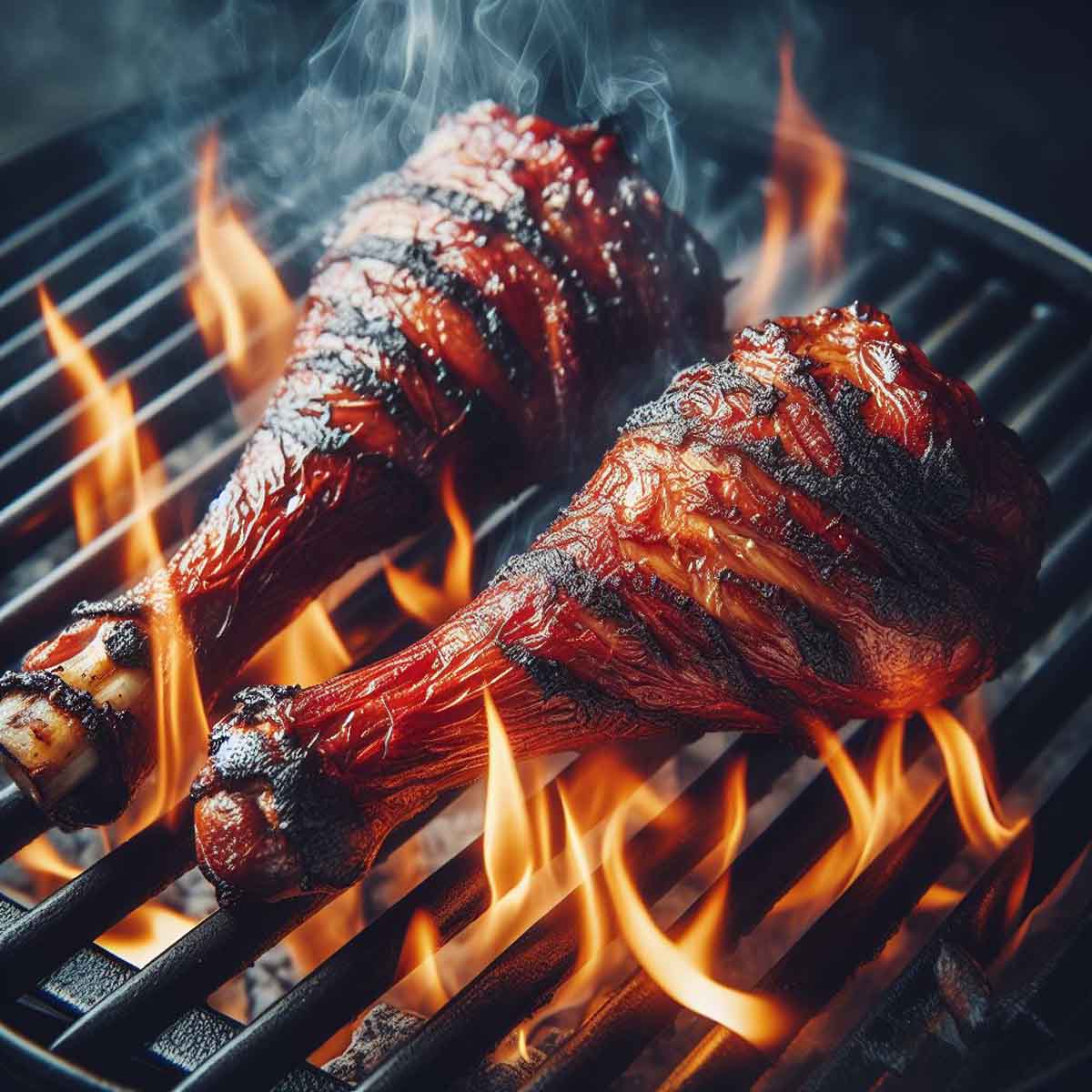
Indirect Grilling for Consistent Heat Distribution
For a gentler approach, particularly if you have larger turkey legs or want to avoid the risk of burning, try indirect grilling:
- Heat one side of your grill, leaving the other side unlit or turned off (for gas grills).
- Place the turkey legs on the cooler side of the grill to reheat by the surrounding warm air.
- Cover the grill, creating an oven-like environment for even reheating.
- Ensure the internal temperature reaches the safe minimum of 165 degrees Fahrenheit before serving.
This method circulates heat around the turkey legs, reheating them thoroughly without direct exposure to high heat.
Using Aluminum Foil to Retain Moisture
Dry turkey meat is a no-go, so consider wrapping your legs in aluminum foil with a touch of moisture. Here’s how:
- Lay out a sheet of aluminum foil large enough to wrap each turkey leg.
- Before sealing, add a splash of chicken stock or a little water to the foil packet.
- Crimp foil edges to create a sealed environment, trapping steam inside.
- Grill on medium heat, and use a meat thermometer to check doneness.
The foil traps the steam, gently reheating the turkey legs while keeping them moist and tender.
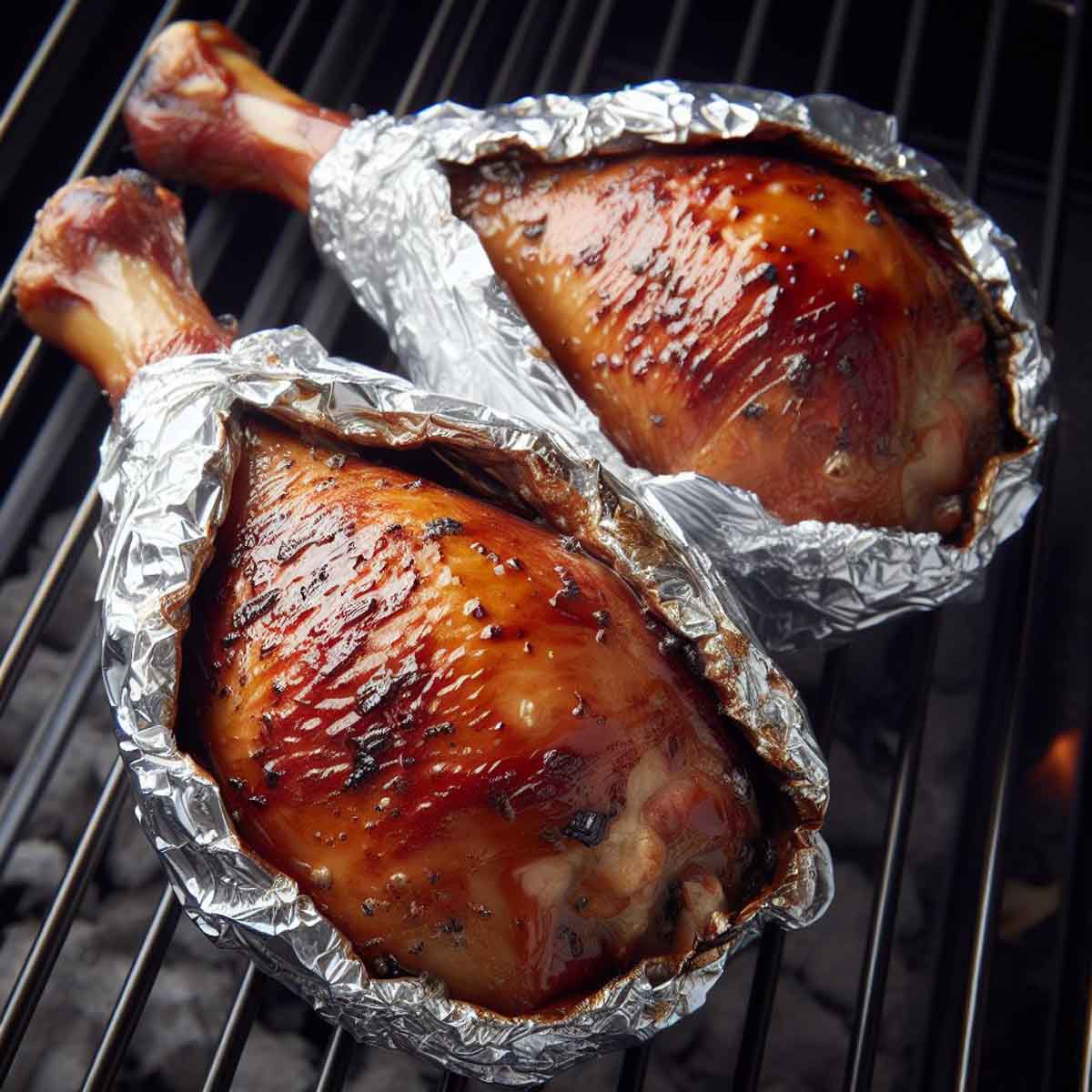
Glazing with Sauces for an Additional Flavor Kick
Enhance the flavor of your smoked turkey legs with a homemade glaze:
- Mix brown sugar, a little water, and your favorite seasonings to create a glaze.
- Brush the glaze on the turkey legs during the last 10-15 minutes of grilling.
- Keep an eye out for burning due to the sugar content in the glaze.
This addition gives your turkey that extra zing and a delightful sticky texture.
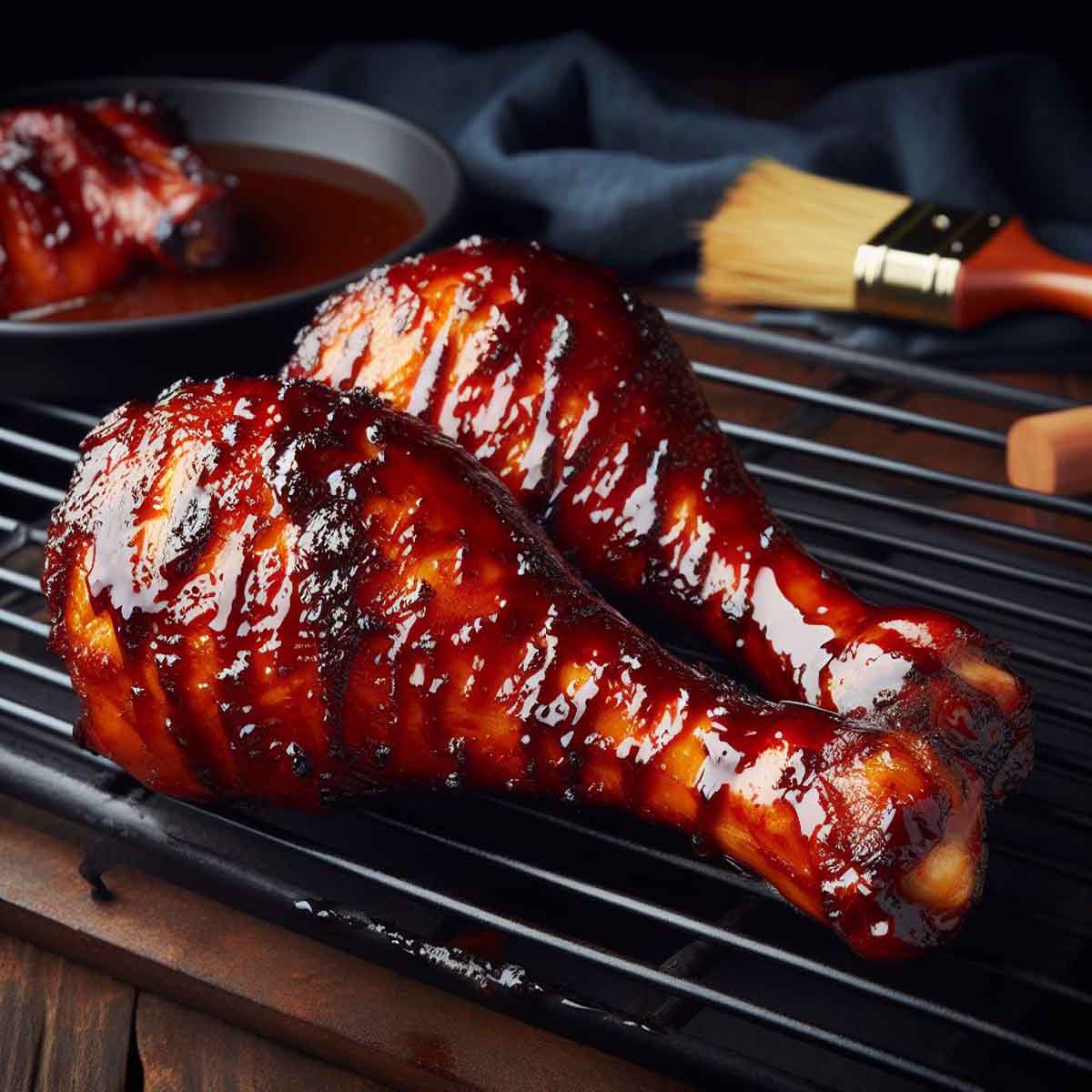
Slow Reheating Process for Evenly Cooked Turkey Meat
For those more patient grill masters, low and slow is the method for you:
- Preheat your grill between 200 and 250 degrees Fahrenheit.
- Place turkey legs on the grill, away from direct heat for slow reheating.
- Cover the grill and periodically rotate the turkey legs for even warming.
- After approximately 1-2 hours, or once the internal temperature hits the 165-degree mark, your turkey legs are ready.
Slow-cooking is superb for keeping the turkey meat juicy and succulent, ideal for those who appreciate the slow art of grilling.
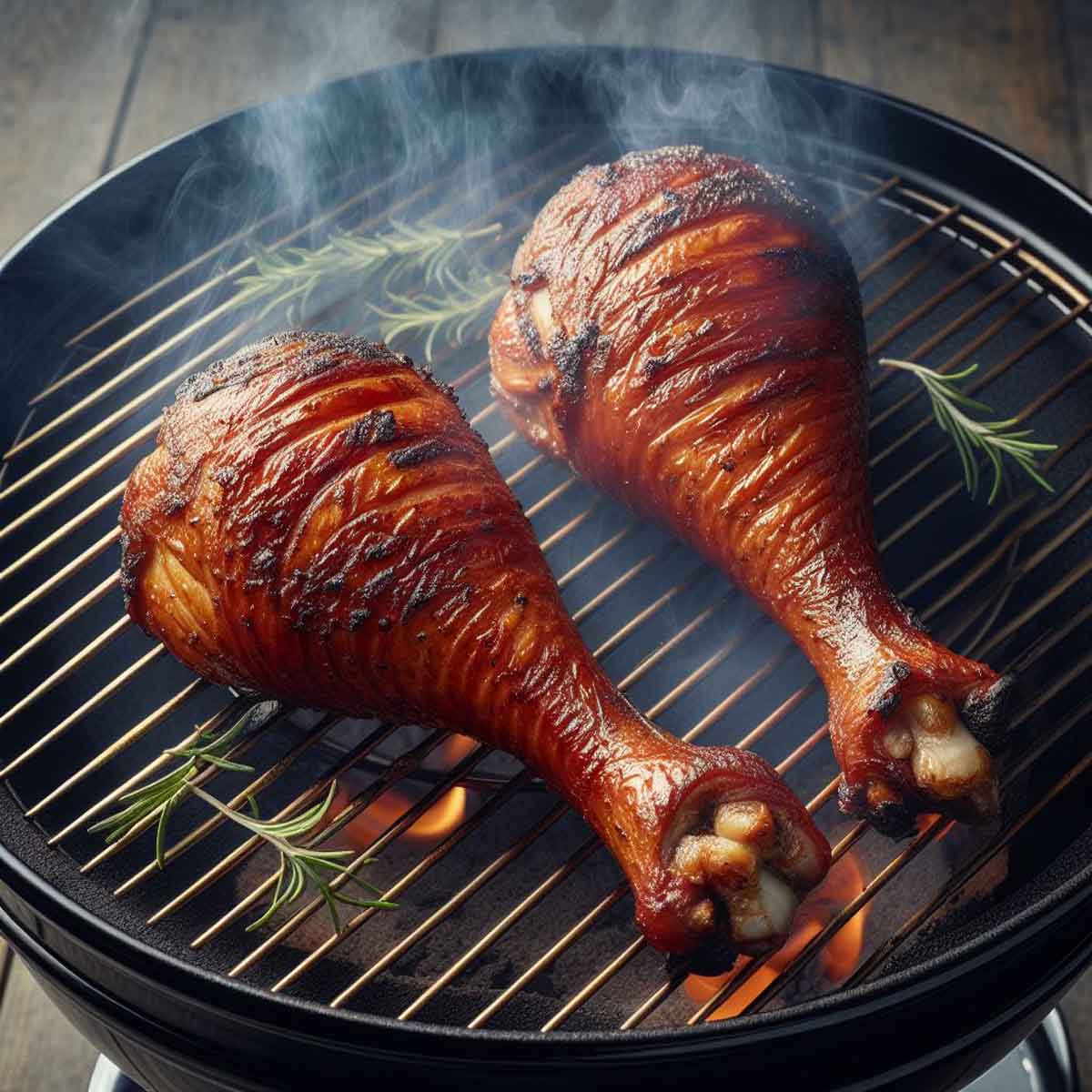
Smoking Process Redux: Enhancing Smoky Flavor
Reintroducing smoked turkey legs to some smoke can revive the original smoky flavor that might have dissipated in the fridge:
- Soak wood chips in water for at least 30 minutes before grilling.
- Heat one side of the grill and place the soaked chips directly on the coals or in a smoker box for gas grills.
- Put the turkey legs on the opposite side of the grill (indirect heat) and close the lid.
- Let the turkey absorb the smoke for 20-30 minutes while maintaining a grill temperature around 225-250 degrees Fahrenheit.
- Ensure an internal temperature of 165 degrees Fahrenheit is reached before serving.
Adding wood chips to the reheating process will give you that fresh-out-of-the-smoker flavor that’s sure to tantalize your taste buds.
Remember, the recommended internal temperature for poultry is 165 degrees Fahrenheit, so always use your meat thermometer to check.
What if Grilling Isn’t an Option?
Low-Temperature Oven Reheating for Grilling Off-Days
If you’re not in the mood for grilling or the weather doesn’t permit, you can still achieve grill-like results with your oven:
- Preheat your oven to 250 degrees Fahrenheit.
- Place turkey legs on a wire rack set inside a rimmed baking sheet.
- Tent the turkey legs with aluminum foil to prevent them from drying out.
- Warm them in the oven until the internal temperature reaches 165 degrees Fahrenheit, about 30 minutes to an hour depending on their size.
Although not on the grill, this method reheats your turkey gently, maintaining its moistness and flavor.
Using a Skillet for a Quick Sear
Maybe you want a little crispness on the skin without firing up the grill. Here’s a stovetop solution:
- Heat a large skillet or frying pan over medium heat with a bit of oil.
- Remove the turkey skin for separate crisping if desired.
- Place the turkey legs in the skillet and cover with a lid.
- Turn the legs occasionally for an even reheat.
- For the skin, place it in the hot pan until crispy, then rewrap it around the meat before serving.
This method offers a quick-and-easy reheating option with a bonus crispy skin finish.
Sous Vide for Perfect Temperature Control
For those who like precision and have a sous vide setup:
- Preheat water with a sous vide immersion circulator to 165 degrees Fahrenheit.
- Place turkey legs in a plastic bag suitable for sous vide cooking and remove the air.
- Submerge the bagged turkey legs in the water bath.
- Allow them to reheat for about an hour to ensure the entire leg is warmed through.
This technique guarantees that your turkey reaches the precise safe temperature without the risk of drying out, maintaining its moisture and tenderness.
Cast Iron Cooking for Robust Flavor
Cast iron cookware is renowned for its heat retention and even cooking; here’s how to use it to reheat your turkey legs:
- Preheat your cast iron skillet or grill pan over medium heat.
- Lightly oil the skillet and add the turkey legs.
- Cover with a lid or aluminum foil to keep the moisture in.
- Turn the turkey legs every few minutes to prevent burning and ensure even reheating.
- Check the internal temperature has reached 165 degrees Fahrenheit before serving.
The cast iron imparts a slightly smoky, grilled flavor and can give your turkey legs some additional char, all from the convenience of your kitchen stove.
There you have it, a plethora of ways to reheat your smoked turkey legs on a grill, in an oven, on a stovetop, and even using sous vide. Each option has its unique benefits, whether you’re seeking to enhance flavor, save time, or ensure juiciness.
Tips and Tricks for the Best Reheated Smoked Turkey Legs
Why Room Temperature Matters Before Grilling
Taking your turkey legs out of the fridge and letting them sit at room temperature for about 20-30 minutes can make a significant difference. This step allows the meat to reheat more evenly and helps reduce the cooking time on the grill, preventing the outside from cooking too much before the inside is warm.
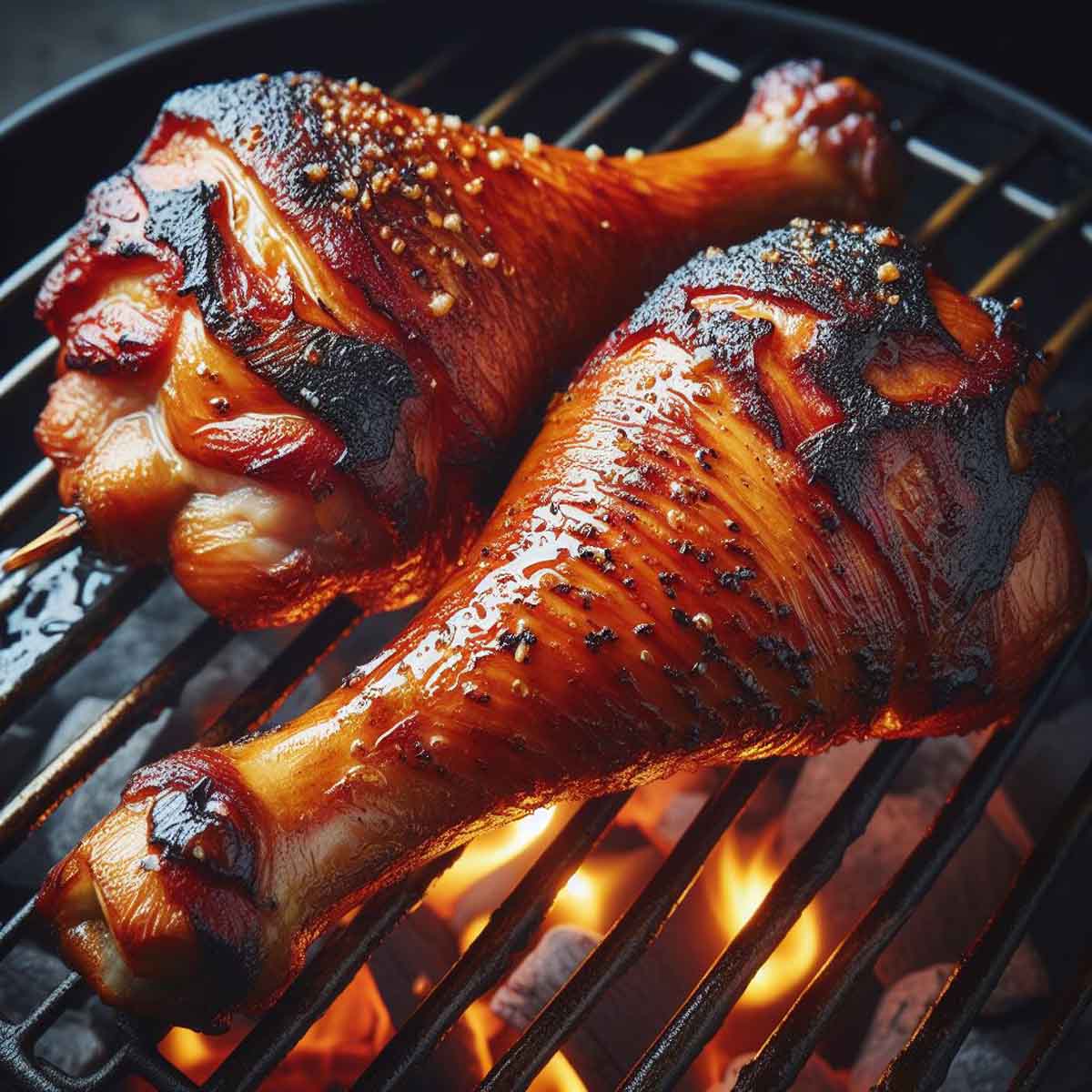
Using Favorite Seasonings to Refresh the Taste
Before you throw those legs on the grill, consider giving them a quick season. Sprinkle on some garlic powder, onion powder, and a pinch of kosher salt, or any of your favorite seasonings. This will refresh and even elevate the taste of the meat as it reheats.
Keeping Turkey Legs Juicy – Adding Moisture as You Grill
Nobody enjoys dry turkey. To keep the legs nice and juicy, try basting them with a bit of olive oil or avocado oil during the reheating process. The oil helps to lock in moisture and also promotes an evenly browned, crispy exterior.
Common Mistakes to Avoid When Reheating on a Grill
Overheating and Drying Out the Meat
Patience is a virtue, especially when reheating meat. High heat might seem like a quick solution, but it’s a common pitfall that often leads to dry, overcooked turkey. Stick to medium or indirect heat for best results.
Ignoring the Internal Temperature Guidelines
Always use a meat thermometer to ensure your turkey legs reach the safe internal temperature of 165 degrees Fahrenheit. Consuming undercooked turkey isn’t just unsatisfying; it’s unsafe.
Reheating Without the Right Equipment
Do you have your grill tools and meat thermometer at the ready? Having the right equipment on hand can make the difference between guesswork and perfect results. This is as true for turkey legs as it is for grilled frozen chicken and frozen ribs.
Serving and Enjoying Your Perfectly Reheated Smoked Turkey Legs
Carving: How to Serve a Whole Turkey Leg
When it’s time to serve your reheated smoked turkey legs, presentation can be as impressive as taste. If you’re serving whole legs, provide each diner with a sturdy plate, as turkey legs can be a hands-on affair. For a more refined experience, you can carve the meat off the bone:
- Allow the turkey legs to rest for a few minutes after reheating.
- Use a sharp knife to slice down the length of the leg, following the bone.
- Once you’ve sliced as far down as you can, begin to gently scrape the meat off the bone.
Proper carving ensures your guests get to enjoy every last morsel of flavorful meat without the challenge of navigating the bone.
Pairing Ideas: Choosing Your Favorite Sides
The right pairing can elevate your smoked turkey legs to a full-on feast. Here are some great accompaniments:
- Sweet and tangy cranberry sauce offers a fruity contrast to the meat’s richness.
- Classic mashed potatoes or sweet potatoes provide a comforting base.
- A tangy coleslaw or roasted vegetables adds freshness and cuts through the fat.
- Cornbread alongside turkey legs is a match made in heaven, providing a sweet and savory balance.
Your choice of sides is also a chance to tailor the meal to personal preferences, dietary needs, or seasonal availability.
Storing Leftover Smoked Turkey Legs
Even after a feast, you might find yourself with leftovers. Here are some best practices for storing:
Best Practices for Airtight Containers
Storing your turkey legs properly is paramount for maintaining quality and safety. Place any leftovers in airtight containers or wrap them in plastic wrap or aluminum foil. Proper storage can extend their shelf life to 3-4 days in the refrigerator or up to a few months in the freezer.
Reheating Leftovers: Is It Still Safe and Tasty?
Reheating turkey legs a second time is perfectly safe as long as you ensure the internal temperature reaches 165 degrees Fahrenheit every time. However, be mindful that repeated reheating can degrade the meat’s quality, possibly resulting in drier meat.
Look for signs of proper reheating, such as steam releasing from the meat and a consistent internal temperature. To identify freezer burn, look for ice crystals and discoloration on the turkey legs.
FAQs: Answering Your Top Questions on Reheating Smoked Turkey Legs
- How Long Do I Reheat Smoked Turkey Legs on a Grill? It depends on the temperature of the grill and the size of the legs but typically, it takes about 15 to 30 minutes on medium heat.
- Can I Use a Gas Grill Instead of a Charcoal Grill? Absolutely. The methods discussed apply to both gas and charcoal grills, with temperature control being the key factor.
- What’s the Recommended Oven Temperature for Those Without a Grill? If using an oven, aim for a low temperature of around 250 to 350 degrees Fahrenheit to prevent drying out the meat.
- Tips for Reheating in an Air Fryer Basket Set your air fryer to 350 degrees and cook for about 10 minutes. Be sure to check the internal temperature to ensure the turkey is heated thoroughly.
Remember, the internal temperature is key in safe poultry preparation, as emphasized by the FSIS.
Key Takeaways for Reheating Smoked Turkey Legs on a Grill
By now, you should feel fully equipped to reheat smoked turkey legs to perfection. Remember, the goal is to warm the turkey through to a safe internal temperature while maintaining its moisture and flavor. Choose the method that best suits your taste, available equipment, and time constraints.

